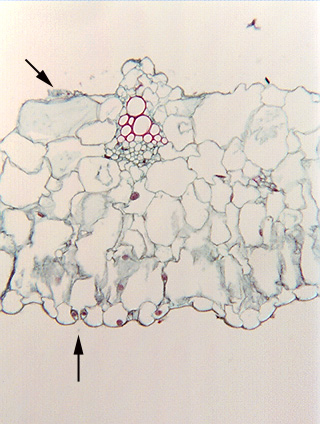 Fig.
10.2-15. Transverse section of onion leaf (Allium cepa). This
leaf transverse section is different from most in this chapter: there is an
epidermis on the lower side of the micrograph (vertical arrow points to a
stoma), but there
is no upper epidermis (diagonal arrow points to cell debris). This is
from the green part of an onion leaf, not the white part. The green part of the
leaf is hollow because the leaf tissues have torn apart, and that is
what we are seeing on the top part of this micrograph. You can tell that the
upper layer here is not an epidermis because the cells have irregular sizes and
shapes. Although this layer lacks stomata, that is not an absolute criterion for
saying that this is not epidermis: many true epidermises lack stomata (many
petals and stamens, for example).
Fig.
10.2-15. Transverse section of onion leaf (Allium cepa). This
leaf transverse section is different from most in this chapter: there is an
epidermis on the lower side of the micrograph (vertical arrow points to a
stoma), but there
is no upper epidermis (diagonal arrow points to cell debris). This is
from the green part of an onion leaf, not the white part. The green part of the
leaf is hollow because the leaf tissues have torn apart, and that is
what we are seeing on the top part of this micrograph. You can tell that the
upper layer here is not an epidermis because the cells have irregular sizes and
shapes. Although this layer lacks stomata, that is not an absolute criterion for
saying that this is not epidermis: many true epidermises lack stomata (many
petals and stamens, for example).